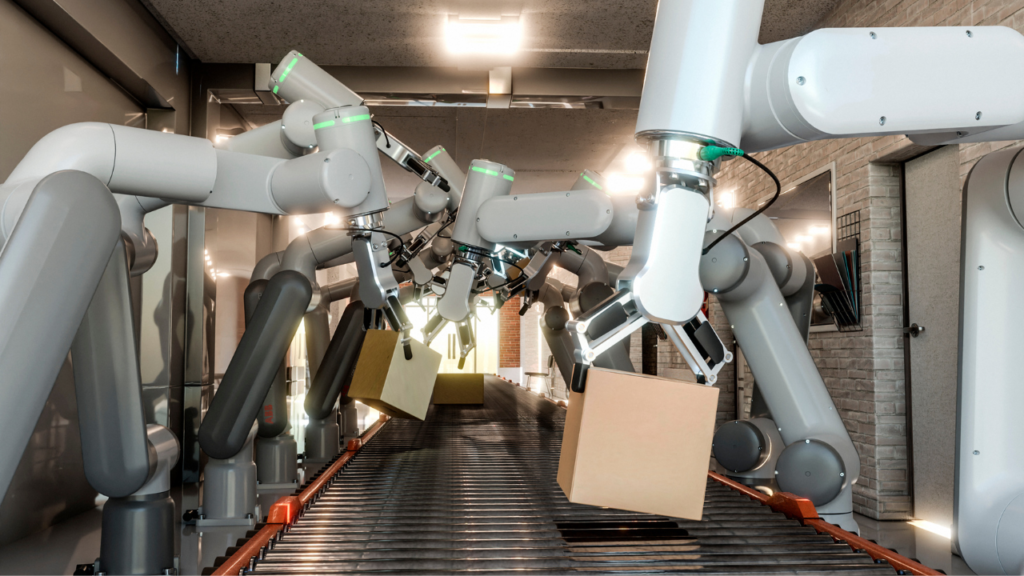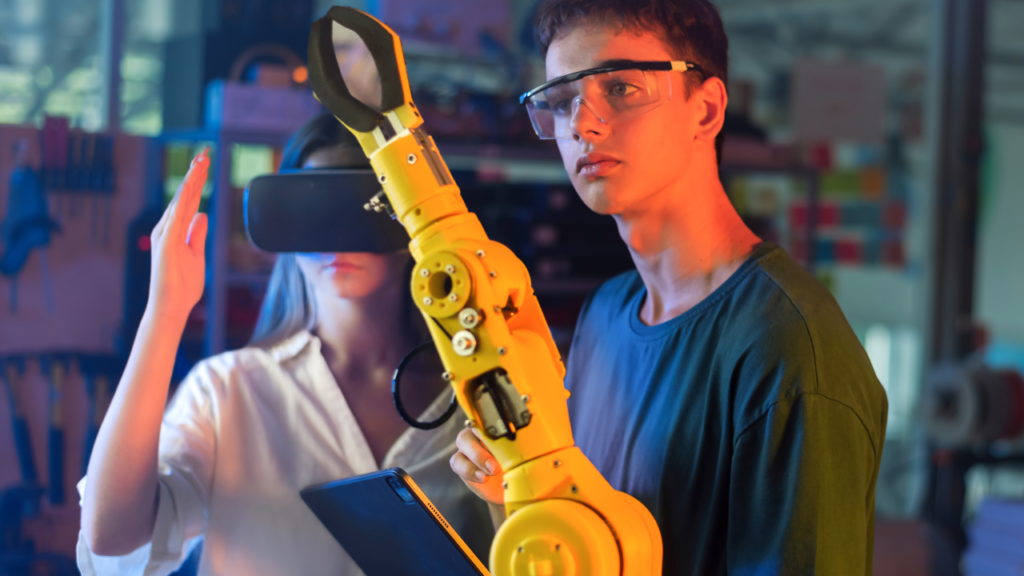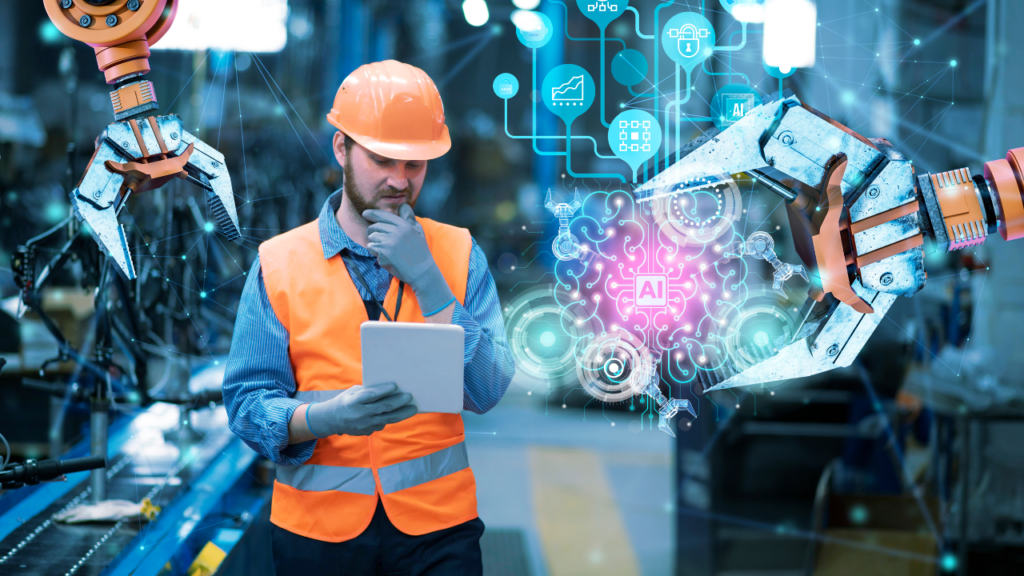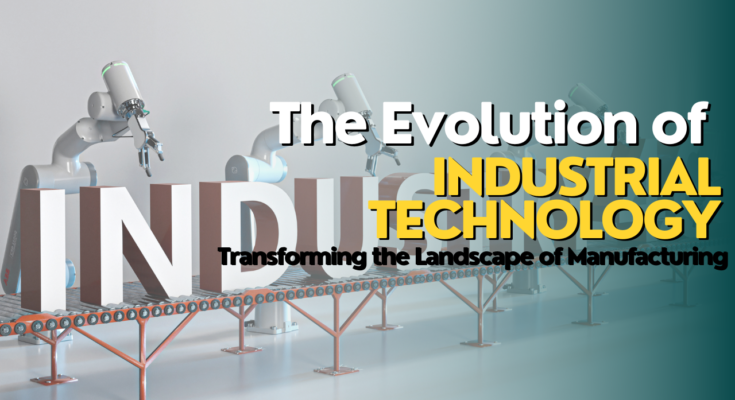The Evolution of Industrial Technology: Transforming the Landscape of Manufacturing
Introduction:
Any technology that is predominantly employed in engineering or manufacturing is considered industrial technology. Industrial technology is a subject of study and job that demands knowledge of technology, business management abilities, and the capacity to apply both to solve issues and expedite production. Industrial technology is used in all large-scale manufacturing sectors, including food production, aviation, and construction. In order to operate inside technological systems, manufacturing processes, and human work settings, it is necessary to comprehend networks and identify any issues or inefficiencies they may have.

1. The Era of Mechanization:
Mechanization in manufacturing began in the late 18th century with the technological advance. The first wave of industrialization was driven by steam engines, water wheels, and other mechanical breakthroughs. Machines took the role of manual labor in factories, increasing production capacity and enabling the mass manufacture of products. The foundation for further developments in industrial technology was laid during this time.
The Steam-Powered Catalyst
The early boom in mechanization was fueled by brilliant innovations like steam engines. These technical wonders, coupled with water wheels and other mechanical advancements, signaled the beginning of the industrial revolution. Steam engines, in particular, played a critical role in ushering in a new era in which machines took center stage, reducing manual labor in manufacturing.
Shifting Dynamics: Machines as Labor Pioneers
With the development of mechanization, machines effortlessly acquired the tasks previously held by human hands. This paradigm change not only expanded manufacturing capacity, but also paved the way for the mass manufacture of a wide range of items. Factories changed into innovation hubs, with automation boosting efficiency and productivity.
Building Blocks for Technological Advancement
The mechanization wave created a solid platform for later advances in industrial technology. The incorporation of machines into production processes paved the way for a constant evolution, with each invention building on the success of its predecessor. The mechanization age of the late 18th century did, in fact, serve as a catalyst for the continued development of the industrial environment.
2. The Rise of Automation:
Automation emerged in the middle of the 20th century, bringing with it a fresh round of innovations for industrial operations. PLCs and assembly lines became indispensable to production, allowing for the faster and more accurate completion of repeated operations. For more advanced automation systems that would be developed in the years to come, this phase set the foundation.
Pioneering Automation Technologies
As the twentieth century proceeded, the incorporation of PLCs represented a paradigm leap in industrial automation. PLCs, which have programmable memory, have revolutionized the landscape by allowing for remarkable accuracy in controlling machines and processes. This crucial invention set the way for a new era of efficiency by removing the need for physical involvement in regular processes.
The Future of Automation
Fast forward to now, when automation has become a crucial component in many enterprises. The continuous refinement of automation technologies has led in the creation of machines that can learn and adapt to changing circumstances. Automation has evolved from robotics to artificial intelligence, creating an all-encompassing environment with immense future possibilities.
3. Computer Numerical Control (CNC) and Robotics:
The incorporation of computers into production processes increased accuracy and control. CNC machines, controlled by computer programs, enabled the automated manufacture of complicated components with little human interaction. Robotics transformed the industry by providing adaptable and programmable devices capable of managing complex tasks, resulting in greater industrial efficiency and quality.

Adaptable and Programmable Robotics
The use of robots has catapulted the industrial industry into a new age of flexibility and programmability. Unlike traditional machinery, robotics provides a dynamic method for managing complicated jobs. These programmable devices are both efficient and versatile, allowing for unprecedented flexibility in production processes.
Managing Complexity With Ease
One of the most distinguishing qualities of robots is their capacity to tackle complex and complicated jobs with ease. From assembly lines to intricate production methods, these adaptive devices improve industrial process efficiency. As a result, total productivity increases significantly, as does product quality.
4. The Emergence of Smart Factories:
The concept of “smart factories” has lately gained popularity, referring to the integration of industrial technology with the Internet of Things (IoT). The employment of sensors, networking, and data analytics enables the creation of networked production systems that respond to real-time demand changes. In addition to enhancing efficiency, this link facilitates predictive maintenance, reducing downtime and disruptions to the manufacturing process.
Connecting the Dots: Industrial Technology and IoT
The combination of industrial technologies and the huge potential of the Internet of Things (IoT) serves as the foundation of smart factories. These factories use sensors, powerful networking, and sophisticated data analytics to build a synchronized production environment that can dynamically respond to real-time demand fluctuations.
Proactive Approach: Predicting Maintenance Needs.
The integration of IoT in smart factories brings a game-changing feature: predictive maintenance. These factories can anticipate possible maintenance difficulties before they worsen thanks to constant monitoring enabled by sensors and data analytics. This proactive strategy saves downtime and ensures that the production process runs smoothly.
Downtime Defence: Reducing Disruptions
Smart factories, equipped with predictive maintenance capabilities, become a bulwark against interruption. By diagnosing and correcting possible faults before they create catastrophic failures, these factories save downtime and ensure a constant and uninterrupted manufacturing flow.
5. Artificial Intelligence (AI) in Manufacturing:
Intelligent manufacturing has entered a new age with the incorporation of artificial intelligence. Large volumes of data are analyzed by machine learning algorithms to improve supply chain management, quality control, and production process optimization. Artificial intelligence (AI)-powered systems may learn from patterns, optimize themselves, and adjust to changing production conditions, all of which boost efficiency and lower costs.

Precision Monitoring and Detection
In the quest of perfection, intelligent manufacturing depends on AI-powered quality control processes. These systems rigorously track manufacturing processes, detecting deviations and abnormalities in real time. The end result is a precision-oriented approach to quality assurance, with fewer faults and each product meeting or exceeding the highest standards.
Adaptive Learning for Continuous Improvement.
AI-powered quality control systems go beyond simple monitoring and participate in adaptive learning. These systems’ accuracy improves over time as they evolve in response to fresh data and insights. This iterative method contributes to an ongoing cycle of improvement, keeping up with the dynamic nature of production and ensuring constant, high-quality output.
6. 3D Printing and Additive Manufacturing:
3D printing, sometimes referred to as additive manufacturing, is another revolutionary development in industrial technology. This technology enables the construction of objects layer by layer, producing intricate designs and reducing material waste. Because it offers a more flexible and ecologically responsible manufacturing process, 3D printing is transforming large-scale production, customisation, and prototyping in a number of sectors.
Skills for industrial technology
Here are some skills that are useful for jobs with industrial technology:
- Math and computer abilities: Strong computer skills are useful for running and communicating with contemporary industrial equipment, while math skills aid in the verification of plans and outcomes.
- Scientific knowledge: Understanding physical and chemical principles can help you design procedures for changing and shaping various materials.
- Organizational behavior: Because many industrial technology occupations revolve upon how people interact with industrial technology, professionals in the industry must grasp the principles, motives, and theories that control this behavior.
- CAD/CAM: Familiarity with software is essential for industrial technology professionals who use it to develop and manufacture products.
- Hand-eye coordination is crucial while utilizing technology and equipment, especially for tasks requiring fine details or heavy materials.
- Attention to detail: Strong attention to detail enables operators and technicians to detect faults or harmful problems and accurately record progress and corrections.
- Communication: Clear written and verbal communication is critical since a mistake or miscommunication about heavy gear might jeopardize equipment workers.
Career Opportunities

Graduates of the Master of Industrial Technology and Operations program are well-prepared to proceed to managerial roles in their chosen area.
- Quality assurance/quality control manager
- Inventory control/analyst
- Production planner/scheduler/manager
- Process/continuous improvement manager
- Manufacturing engineer/manager
- Operations/general manager
- Supply chain analyst/manager
- Logistics planner/manager
- Demand planner
- Purchasing specialist/analyst
- Sales and operations planner
- Environmental services manager
- Project manager
- Facilities coordinator/manager
- Construction supervisor/manager
- Field engineer/manager
Top Programs in Industrial Technology: Where Innovation Meets Practicality
Industrial technology, the driving force behind our contemporary world, provides intriguing job opportunities for people intrigued by the delicate dance of engineering, production, and invention. However, understanding the different landscape of programs may be challenging. To help you get started, here’s a carefully chosen list of top programs organized by specialty and degree level:
| Sr | Program | Top Schools |
| 1 | Associate of Applied Science (AAS) in Industrial Technology | Purdue University Northwest, Ferris State University, Rochester Institute of Technology |
| 2 | Associate of Science (AS) in Industrial Technology | Georgia Institute of Technology, University of Massachusetts Lowell, California State Polytechnic University |
| 3 | Bachelor of Science (BS) in Industrial Technology | Massachusetts Institute of Technology (MIT), Stanford University, Georgia Institute of Technology, Purdue University, University of Illinois Urbana-Champaign |
| 4 | Bachelor of Engineering (BE) in Industrial Engineering | University of Michigan – Ann Arbor, Iowa State University, Ohio State University, Virginia Polytechnic Institute and State University (Virginia Tech), University of California, Berkeley |
| 5 | Master of Science (MS) in Industrial Technology | University of California, Berkeley, Purdue University, Michigan State University, Texas A&M University, University of Wisconsin-Madison |
| 6 | Master of Engineering (ME) in Industrial Engineering | Georgia Institute of Technology, Stanford University, University of Minnesota Twin Cities, University of California, Los Angeles, Pennsylvania State University |
Conclusion:
Automation arose in the middle of the twentieth century, ushering in a new wave of industrial advances. PLCs and machine shops become crucial in manufacturing, enabling for faster and more precise happiness of repetitive duties. For more advanced automation systems that would be developed in the years to come, this phase set the foundation.
General FAQs:
Q: What exactly is industrial technology?
Industrial technology is the use of scientific and technical concepts to improve industrial processes, design and produce goods, and create novel solutions for a variety of sectors, such as robots, 3D-printed prostheses, and smart energy grids.
Q: What are the different areas within industrial technology?
The field is vast, encompassing areas like:
- Automation & Robotics: Developing and implementing machine learning-powered bots to automate tasks, enhance efficiency, and even collaborate with humans.
- Manufacturing & Design: From traditional machining to cutting-edge additive manufacturing (3D printing), designing and creating products with precision and efficiency.
- Materials Science: Engineering new materials with superior properties like strength, conductivity, and sustainability for diverse applications.
- Industrial Analytics & AI: Collecting and analyzing data from machines and processes to optimize performance, predict maintenance needs, and make informed decisions.
- Energy & Power Systems: Developing efficient and sustainable solutions for energy generation, transmission, and distribution.
Q: What are the career options in industrial technology?
The possibilities are endless! You could be a:
- Manufacturing Engineer: Optimizing production lines, designing equipment, and overseeing entire manufacturing processes.
- Robotics Engineer: Developing and programming robots for various tasks, from welding to food packaging.
- Product Design Engineer: Conceptualizing, designing, and testing new products, ensuring functionality and aesthetic appeal.
- Data Analyst: Collecting, analyzing, and interpreting industrial data to drive decision-making and improve efficiency.
- Sustainable Manufacturing Specialist: Implementing eco-friendly practices and materials within production processes.
Q: What kind of education do I need for a career in industrial technology?
There are various paths to success:
- Associate’s Degrees: AAS or AS programs provide introductory knowledge and prepare you for technician or operator roles.
- Bachelor’s Degrees: B.S. or B.E. programs offer in-depth study in specific areas, opening doors to engineering, management, and research roles.
- Master’s Degrees: MS or ME programs further enhance your expertise and specialize in areas like automation, AI, or sustainable manufacturing.
Q: Where can I find the best programs in industrial technology?
Top universities include:
- MIT
- Stanford University
- Georgia Institute of Technology
- Purdue University
- University of California, Berkeley
- University of Michigan – Ann Arbor
Remember, research program strengths, faculty expertise, and internship opportunities to find the perfect fit for your goals.
Q: What are the future trends in industrial technology?
The future is brimming with exciting possibilities:
- Cyber-physical systems: Merging physical and digital worlds, allowing factories to adapt in real-time based on data.
- Artificial intelligence: AI driving smarter machines, automated design and problem-solving, and predictive maintenance.
- Additive manufacturing: 3D printing revolutionizing product design, customization, and on-demand production.
- Sustainable materials: Development of eco-friendly materials to minimize environmental impact and promote circular economy.
Q: How can I prepare for a future in industrial technology?
Stay ahead of the curve by:
- Developing strong STEM skills (science, technology, engineering, math).
- Embracing digital literacy and data analysis skills.
- Learning about emerging technologies like AI and robotics.
- Seeking internships and hands-on experience in industrial settings.

